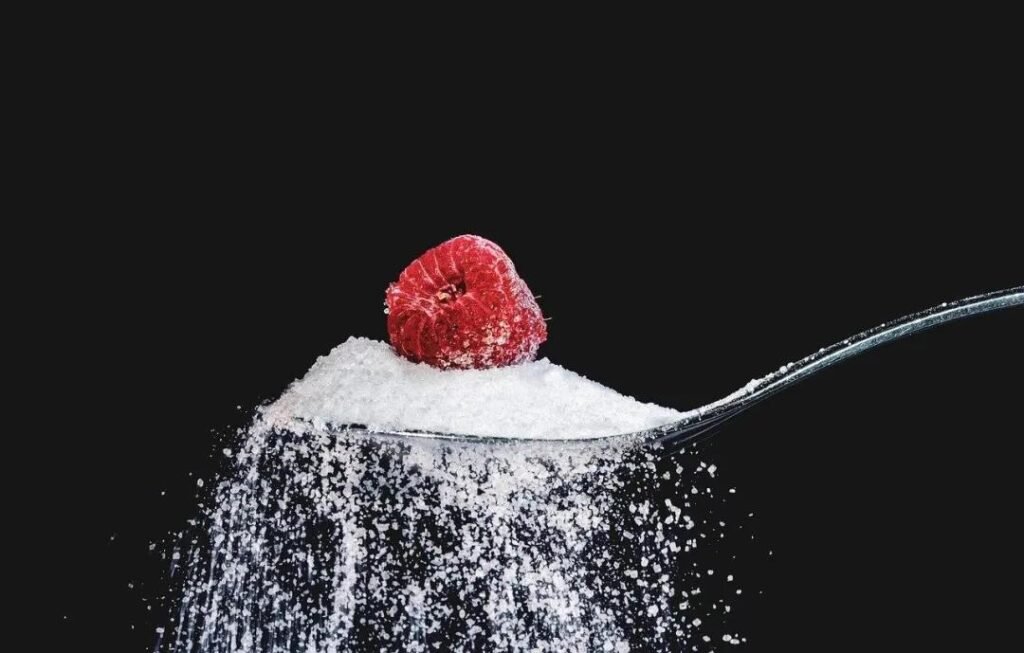1 Erythritol
According to Innova Market Insights, the sweetener with the highest compound annual growth rate globally between July 2016 and June 2021 is erythritol, at 32%. And another popular sweetener, stevia, has a compound annual growth rate of 13%. Erythritol has become the hottest sweetener in the world.
Erythritol is currently the only sugar alcohol product on the market that is naturally transformed and extracted by biological fermentation. It is a zero-calorie sweetener, does not participate in human blood glucose metabolism, and has a sweetness characteristic similar to that of sucrose. Compared to synthetic sweeteners such as sucralose, erythritol can be classified as a natural sweetener. Compared with natural sweeteners such as steviol glycosides, erythritol has a purer taste and no post-bitterness, so it has been recognized by consumers.
However, the sweetness of erythritol is only 70% of that of sugar, and the dosage is large, but the production capacity is seriously insufficient. As a result, there is a global shortage of erythritol. Since the beginning of this year, the market price of erythritol has continued to rise from 16,000 yuan/ton at the beginning of the year, forcing companies to reduce the amount in order to reduce costs. How to reduce the amount of erythritol while maintaining the same taste has become a new topic in the industry.

How to reduce the amount of erythritol?
1) Add fiber
In addition to providing sweetness, some fibers can replicate the function of sugar, serving as flavor enhancers, leavening agents, or bulking agents. At the same time, they can also add a gut-health-promoting effect to the product.
Naturally, occurring inulin is about 10% sweeter than sucrose, and the sweetness increases if the inulin chain is shorter. Short-chain inulin provides 60% of the sweetness level of sucrose. It can partially replace erythritol, providing sweetness and bulk.
Another fiber that can be used to reduce the amount of erythritol is gum arabic. Due to its physical and functional properties, it is a good choice for increasing the fiber content of foods without compromising the appearance or flavor of the food. As a low-viscosity thickener, gum arabic helps compensate for lost volume, texture, and mouthfeel in reduced-sugar products, provides stability by reducing water activity, and improves softness and mouthfeel by increasing water retention.
2) Add food flavor
Another way to reduce the amount of erythritol is to add natural flavors. Erythritol is generally used with other high-intensity sweeteners. Its main purpose is to alleviate the bad taste of high-intensity sweeteners. Natural flavors can speed up the sweetness and eliminate sweetness and peculiar smells by providing aroma and supplementing the real sucrose flavor that is missing when high-intensity sweeteners reduce sugar. This creates a pleasant overall flavor. Even reducing the amount of erythritol can ensure the same taste. The main components of such natural flavors are usually glucosyl steviol glycosides, African arrowroot extract (thomastin), etc.
2 Steviol glycosides
Consumer interest in stevia also continues to grow. According to Innova Market Insights, the number of stevia-containing products launched globally has grown by more than 16% annually between 2016 and 2020. The global stevia market was valued at USD 637.1 million in 2018 and is expected to reach USD 1,169.4 million by 2026. The CAGR from 2019 to 2026 is 8.0%. According to Ingredion’s internal analysis, the global stevia market size is estimated to exceed USD 1.6 billion by 2028.
As the steviol glycosides with high sweetness and no bitter aftertaste, such as Rebaudioside M and Rebaudioside D, gradually occupy the mainstream market. Promoting the improvement of regulations in various countries has become a major event for the stevia industry in 2021. To further regulate the steviol glycoside sweetener market, the European Union has issued new labeling guidelines, which amend (EC) No 1333/2008 and (EU) No 231/2012 to divide the original steviol glycosides (E 960) into two Fractions, including steviol glycosides from Stevia (E 960a) and steviol glycosides from enzymatic production (E 960c). Provide consumers with greater clarity and transparency, help consumers better identify the source of steviol glycosides used in food, and deepen their understanding of natural plant-derived stevia.
The new version of China’s “National Food Safety Standards Food Additives Stevioside” draft also revised the definition of stevioside. Based on GB 8270-2014, four new glycosides including rebaudioside E, rebaudioside N, rebaudioside O, and rebaudioside M were added, and the molecular formula and structural formula of 13 glycosides were added. and relative molecular mass.

3 Monk fruit
The global monk fruit market was valued at USD 396.34 million in 2019 and is expected to reach USD 532.17 million by 2026 at a CAGR of approximately 4.3%. Because it can be directly labeled as Monk fruit on the label and not an additive, Monk fruit is considered a clean-label sugar substitute. According to SPINS data, the use of monk fruit in clean-label food and beverages in the U.S. market in 2020 increased by 15.7%. With a plethora of health benefits, the market is likely to gain greater growth momentum in the coming years.
In addition to its great advantages in blood pressure and blood sugar management, monk fruit also has a certain relieving effect on respiratory diseases including cough. In addition, it has a high antioxidant content and has a long shelf life. In terms of market, the monk fruit market is divided into natural and organic markets. Based on regions, the monk fruit market can be divided into five major regions: Latin America, North America, Asia Pacific, Europe, and the Middle East and Africa. North America is expected to make the largest contribution to the monk fruit market. The European market will be one of the most lucrative in the next few years, as consumers in the region have a high demand for natural zero-calorie sweeteners. Markets such as Asia Pacific, Latin America, the Middle East, and Africa will become regions with great potential. These markets have not been fully developed, and there is a need for business expansion, especially in China, the origin of monk fruit.
4 Allulose
In 2019, the FDA announced that it would exclude the low-calorie sweetener allulose from the “added sugars” and “total sugars” labels. At the same time, the calorie of allulose was set at 0.4kcal/g. This policy promoted the mass production and use of allulose. In North America, the number of new products containing allulose tripled in 2020 compared to 2019. Future market insights predict that the allulose global market will reach $450 million in 2030, growing at a CAGR of 9.1%.

At present, the consumer awareness of allulose is still low. In the 2020 Innova global health and nutrition survey, the label of the sweetener in consumers’ hearts is stevia: 30% healthy, 24% natural, and 21% sustainable, Allulose is 15% healthy, 10% natural, and 14% sustainable. Although allulose cannot be used in China at present, some companies have started the research, development, and production of allulose.
5 Other new sugar substitute products for 2021
1) ADM: low sugar glucose syrup
At the beginning of the year, ADM launched Sweet Right Low Sugar Glucose Syrup (RSGS) in the US market. It can replace traditional corn syrup in a variety of applications, helps bulk and bind low-sugar formulations, and provides viscosity comparable to traditional corn syrup for ease of processing. When paired with other high-intensity sweeteners, it reduces sugar by more than 30%.
SweetRight RSGS can be used in low-sugar ice cream to provide emulsion stability, as well as freezing and thawing properties needed to maintain the structure and texture of frozen foods. In addition, RSGS can replace a portion of sugar or syrup in baked goods while maintaining moisture and a consistent texture throughout the shelf life of the baked goods.
2) Doux Matok launches the first Incredo Sugar finished product
DouxMatok releases its first direct-to-consumer product. It features the use of Incredo Sugar. This is a new sugar reduction solution that reduces sugar by 30% to 50%.
The two limited-edition Incredo Spreads launched in the U.S. have nearly 50 percent less total added sugar than other similar products, while also adding fiber. Two tablespoons of Incredo Spreads also provide 30% of the daily recommended fiber intake. They are made from organic hazelnuts and are free of gluten and artificial flavors, colors, and preservatives. Incredo Sugar is featured in the spread. Based on a sugar-reduced solution made from real sucrose, it enhances the perception of sweetness by increasing the efficiency of sugar delivery to sweet taste receptors, resulting in dramatic reductions in sugar without compromising taste, mouthfeel, or texture. It is suitable for applications such as cakes, snacks, cookies, chocolate, candy, protein bars, and baked goods.

3) Sweegen: Brazzein sweetener
At this year’s SUPPLY SIDE WEST show, Sweegen and partner Conagen launched the Brazzein sweetener, which will be available in early 2022. This sweetener uses a patented precision fermentation process and can be mass-produced in a sustainable manner. It can be used in combination with Sweegen’s stevia for good synergistic advantages.
4) Supplant: Sugar from Fiber
The company Supplant has launched Supplant sugar from fiber. This is a blend of sugar substitutes naturally found in plant fibers and has been shown to reduce calories in foods. The company uses a patented method to make cellosugars from the straw, stalks and cores of corn, wheat and rice. Proven to work in a variety of categories including baked goods, cereal, chocolate and ice cream.
According to the company, Supplant sweeteners caramelize, bake and cook like traditional sugar, providing bulk, texture, structure, browning, and sweetness. It has 1.8 calories per gram of sugar compared to 4 calories per gram of sugar. Supplant is also a prebiotic. Once produced on a full industrial scale, the price of Supplant sugar will be more competitive with conventional sugar because it comes from scrap.
5) Fooditive: Sweeteners Based on Banana Waste
Tropical fruit processor Frutco has partnered with plant-based ingredient supplier Fooditive to build a new product in Europe with a banana peel-based sweetener to reduce food waste. As part of the collaboration, Fooditive and Frutco are building a waste and residue-based biofactory to process bananas and tropical fruits into fruit extracts and sweeteners.
The product will be positioned as a sustainable sweetener. While naturally healthy, it helps eliminate carbon emissions from the supply chain and is a 100% sugar substitute. It has also shown excellent performance in many applications such as chocolate, dairy, and beverages. The ability to process ripe banana peels into 99.7% erythritol (E968) has been verified in the laboratory. In addition, “banana extract” (banana sweetener) can be produced by continuous fermentation. The ingredient in this form avoids the regulation of additive number labels, thereby providing a clean label alternative that functions very similarly.

